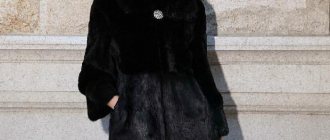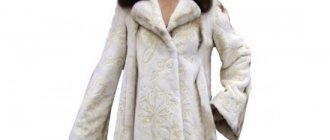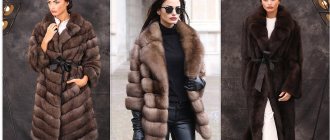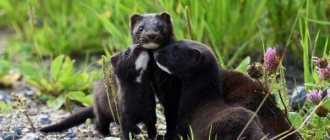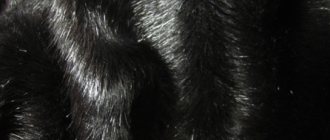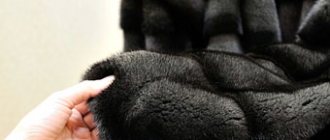Scandinavian mink coats: advantages
Why are there so many fans of Scandinavian mink fur? There are many reasons for this:
- It's very warm. After all, its guard villi are long throughout the entire skin. This protects even from severe frosts.
- Scandinavian mink fur undergoes careful control before sale. Accordingly, all products made from it are of high quality.
- The most popular fur coats are made from black Scandinavian mink. Shiny, smooth, stylish, they look incredibly luxurious. It’s not for nothing that such products are called “black diamonds.”
- The underfur of this fur is dense and beautiful.
- Scandinavian mink is wear-resistant.
- This fur is waterproof, which is important for the domestic climate.
Kinds
There are several varieties of Scandinavian mink:
- Danish selection, or Kopenhagen Furs. This fur has a smooth, very delicate and rather low spine.
- The Finnish selection, or Saga Furs, has a rough awn and a fairly high pile height.
- "Mixed" Scandinavian mink. For example, a popular option is “Danish corduroy”. Externally, this species is similar to the fur of the North American selection.
High-quality Scandinavian mink is most often sold in Copenhagen, at the Kopenhagen Furs auction. The best options:
- SAGA Royal Mink is considered an exclusive fur.
- SAGA Mink is first grade fur.
Livestock breeders who breed Scandinavian mink have bred a huge variety of natural fur colors of this animal. The most famous and in demand on the market today are brown with a black tint and dark brown. Scanblack receives special attention - such skins make a simply gorgeous mink coat! Scandinavian mink of this color has a pure black tone. Allow only a slight coffee tint.
Copenhagen fur auction
Mink fur production
Of all the furs used in making fur products, mink fur is by far one of the most popular. Changes in the weather, in the financial market, fashion trends, designer wishes and consumer preferences - all of this has a direct impact on how much mink will be raised, what color and type it will be. Currently, approximately 50 million mink are farmed worldwide each year.
Denmark is the world's largest producer of mink skins. Approximately 14 million mink are raised there every year. Other key countries in fur production are: Norway, Sweden, Finland, Iceland, the Netherlands, Poland, Russia, China and the USA.
The main components of mink fur are lint and underfur. The color range of mink fur varies from black to white, including brown in various shades. The classic color of mink fur, which originates from the USA, is brown. However, farmed mink are domesticated animals, like cows, pigs, horses, etc., and this means that certain properties of the fur, such as its color, for example, can be isolated and propagated.
In addition to mink, fox, chinchilla and rabbit are also raised in Denmark.
Fur sorting
After slaughter, farmers send the fur to the Copenhagen Fur Auction. A thorough sorting process is very important. The criteria for sorting fur are as follows: sex, size and color. After the skins are sorted by size, they are sorted by color. This is necessary because each batch of fur received from a farmer is not uniform in color. Even a slight variation in skin color in the finished product will be obvious.
Much of the sorting process is automated using the latest computer technology. The fur is then graded for quality by highly trained experts. At the end, the sorted fur is rechecked again. The skins are then tied into bundles, each of which is assigned a lot number.
The Copenhagen Fur Auction labeling system is the standard for the international fur trade. It is based on advanced technologies and many years of experience in studying customer needs.
As the only ISO-9001 certified auction, the Copenhagen Fur Auction guarantees consistently high grading quality. Sorted fur is divided into four categories, each of which has its own name. The best fur is called Kopenhagen Purple, followed by Kopenhagen Platinum, Kopenhagen Burgundy and Kopenhagen Ivory.
Inspection
Before each auction, buyers have the opportunity to inspect the fur offered for sale. The examination usually lasts 4-5 days. This is an important part of the auction because the fur is not on display during the auction. The buyer only has a catalog with a description of the fur for sale and notes that he will rely on during the purchasing process.
Buyers can view selected bundles of fur, called “show lots,” which represent the entire lot, which can include several million pelts.
Auction
The selling season, with five annual auctions, begins in December, when the furs come out of slaughter, and ends in September, when the remaining furs are sold. Each auction attracts an average of 300 - 500 buyers from all over the world.
At the Copenhagen Fur Auction, each blow of the hammer not only determines the highest bidder, but also sets the price of mink for the global market. Each of these five auctions sells up to 5 million mink pelts and many other types of fur. In just five days, the Copenhagen Fur Auction can sell more than 130 million euros worth of furs, or 1,500 euros per second.
Auctions can be accompanied by online broadcast in real time. This way, buyers and farmers, each through access to their own page, can see how much they have spent or earned.
Labels confirming the quality of fur from the Copenhagen Fur Auction
The Copenhagen Fur Auction is the world's largest purveyor of luxury fur. Products bearing the Copenhagen Fur Auction label are made from fur of unsurpassed quality. Only pelts purchased at the Copenhagen Fur Auction and have been sorted can be labeled with the Copenhagen Fur Auction quality label.
The main sales at the Copenhagen Fur Auction are mink fur, but the Copenhagen Fur Auction fur quality labels also apply to fox, chinchilla and astrakhan fur.
Four types of labels confirming the quality of fur from the Copenhagen Fur Auction
The best fur is fur labeled Kopenhagen Fur Purple Quality. High-quality mink pelts are characterized by their lightness and silkiness due to their ultra-fine, short hair and exceptionally dense and padded underfur.
The second label is Kopenhagen Fur Platinum Quality. Fur with good awning and dense and padded underfur.
Next comes the Kopenhagen Fur Burgundy Quality label. Fur with good awning and dense underfur.
Skins labeled Kopenhagen Fur Ivory Quality are characterized by a harmonious balance between hair and underfur.
Text and photos: © Copenhagen Fur Auction
Translation from English: © PROSHUBU.ru
How to choose?
If you are going to buy a fur coat from a Scandinavian mink, then it is worth remembering that although the Finnish selection has higher fur, its underfur is rare. Therefore, such a fur coat is suitable for mild climates and snowless winters. Do you want to buy a warm product that will save you from frost? Then you should take a closer look at the Danish selection.
All mink coats made from Scandinavian mink are of high quality. But you need to buy them in trusted salons and official stores. This will guarantee the absence of counterfeits.
Chinese mink
Recently, inexpensive mink coats of Chinese origin can often be found in stores. Most often these are skins with a not too thick undercoat and long hair. In their natural form, Chinese skins are rarely used due to a lack of commercial qualities and too large volumes of production, so the fur is fully dyed, sheared, plucked and only then sewn into fur products.
Chinese mink is the same mink, it’s just that its quality is often worse, which is the reason for such a low cost. Remember, a high-quality fur coat should not have fur coming out if you lightly pinch the fur coat. If you run a damp cloth over the fur, it should not stain. If you run your hand over the fur against the grain, the fur should not break, but should easily return to its place. If the fur is sparse and the down is thin, it is better not to buy such a fur coat.
Thus, if we make a kind of rating of mink fur, then the places will be distributed as follows: 1. North American mink; 2. Scandinavian and Russian mink; 3. Chinese mink. A good product always costs a lot of money, and if you are willing to overpay and purchase the product in a store, then give preference to products with quality certificates.
Fashionable fur coats
Today, models of fur coats made from Scandinavian mink in pastel shades are at the peak of popularity. In addition, contrasting options are on trend, complemented by elegant black lines.
“Stardust” are also fashionable models. Dark mink fur is decorated with light fibers. The effect is amazing. And such fur coats look expensive and elegant.
If the choice fell on dark shades, then you should pay attention to the following colors:
- Luxurious black.
- Soft chocolate.
- Nice grey.
- Glamorous graphite.
A wide variety of fur coats are made from Scandinavian mink:
- Manto.
- Bow-tie fur coats.
- Classic models.
- Styles in Chanel style.
Both long and short models are in trend. Sleeves can also be of different lengths. Therefore, every representative of the fair sex today will be able to choose a beautiful mink coat for herself. The main thing is that it emphasizes all the advantages of the figure, hides flaws and fits perfectly into the overall style of clothing.
How to wear?
Fur coats made from Scandinavian mink are rightfully considered a real luxury. That’s why it’s worth wearing them with the right accessories.
- Knitted scarves are prohibited.
- We'll have to give up colored stoles.
- A scarf made of fine wool will do.
- Light scarves made of natural fabric are best suited to such a mink coat.
- A neat and elegant hat is the best headdress to go with a fur coat.
- You can choose a small hat that will be devoid of additional decorations.
- If the fur coat has short sleeves, it must be supplemented with long gloves. It would be better if they were leather.
- Shoes for a Scandinavian mink coat should be of high quality, expensive and elegant. Low boots, boots, boots - it is important that they have a platform or thin heel.
World standard and chinchilla?
At all international fur auctions, finished chinchilla skins are sorted by color and quality, which is a rather delicate matter. In chinchilla breeding practice, chinchilla skins are divided into 5 main categories:
- dark
- less dark
- average
- lightened
- light
Chinchilla skins, which are considered to be of the highest quality, are called “empress” and belong to the first, that is, the highest grade. This is the highest standard. But all other skins belong to the second category (grade). Each color group of skins is divided into 12 more groups in accordance with the purity of the shade. At the last stage, chinchilla skins are sorted into small and large.
Scandinavian mink: how to distinguish a fake?
When you come to the store to buy a fur coat, you shouldn’t buy it right away. The product must be checked carefully. After all, deceptions happen. How to understand that this is a real Scandinavian mink? How to distinguish a fake?
First, you should look at the weight of the product. A fur coat made from mink is much lighter than from any other fur. Most often craftsmen skillfully disguise a ferret, rabbit, beaver or marmot as an expensive product. That is why it is important not to make a mistake in your choice, so as not to purchase a fake. What criteria should you pay attention to?
- The marmot has spiky fur and its fur comes in different lengths. When stroking such a pile will become shaggy. After all, it is not plastic. In the sun, the marmot's fur glows blue.
- The rabbit has soft hair. At the same time, the shade over the entire surface of the skin is uneven. If you pluck the undercoat, some of the hairs will remain in your hands.
- Beaver fur is much coarser than mink. And the skin of this animal is larger. Therefore, it is important to look under the lining before purchasing the product.
- Honorik is also often passed off as a mink. After all, this animal is obtained by crossing a ferret and a mink itself. It can be incredibly difficult to spot a fake. A completely black color and a rather thick brown undercoat will help give away the deception.
- The ferret's fur is distinguished by a high awn and sparse underfur. The animal has a rather unusual color. You can easily spot a fake using it. The underfur of this fur is light, and the awn at the ends has a dark shade. Only straight cut models are made from ferret. Otherwise the seams will show through.
There is no need to rush into choosing and purchasing a Scandinavian mink coat. It’s better to visit several stores, ask consultants about all the nuances, and dispel doubts. It is important to be very attentive to every little detail. Then the purchase will be really profitable. And a real Scandinavian mink coat will last for decades.
Preparing a fur auction
Preparations for each auction begin 1-2 months before its start. Suppliers of chinchilla skins deliver their goods to auction warehouses. The fur must be checked to see if it meets the generally accepted standard. Specialists working in the auction company sort the incoming fur, after which the fur pelts are divided into lots, which consist of skins of the same quality and color. From each such large lot, one sample is taken for demonstration (show lot). At the same time, an auction catalog is being prepared containing a list of all lots available at the auction.
A few days before the start of the auction, all potential buyers can take advantage of the opportunity to inspect the sellers' lots. Inspection of the goods is a mandatory procedure for all existing fur auctions , therefore, according to the terms of the auction, all claims received from buyers in the event of detection of any fur defects after purchasing the skins (except for hidden ones) will not be accepted after the end of the auction.
The auction itself opens on the appointed day and at the appointed time in a hall specially designed for this purpose. The auction presidium (auctioneer and his assistants) is located on a raised platform at the table facing the buyers. The task of the presidium is to monitor the behavior of buyers who take part in the auction.

